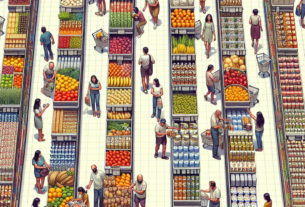Introduction
The grocery retail industry is a highly competitive sector with numerous players vying for market share. In recent years, convenience has become a key differentiator for grocery chains as consumers seek ways to streamline their shopping experience. This report will delve into which grocery chains are leading the charge when it comes to convenience and what strategies they are employing to stay ahead of the competition.
Market Overview
The global grocery retail industry is a massive market with an estimated value of over $8 trillion. The industry has experienced steady growth in recent years, driven by factors such as population growth, urbanization, and changing consumer preferences. In 2025, the industry is expected to continue its upward trajectory, with emerging markets in Asia and Africa presenting significant growth opportunities.
Market Share
When it comes to market share in the grocery retail industry, a few key players dominate the landscape. According to recent data, the top five grocery chains in the world hold a combined market share of over 30%. These include Walmart, Costco, Kroger, Tesco, and Aldi. These players have established themselves as industry leaders through a combination of competitive pricing, strong brand recognition, and extensive distribution networks.
Financial Performance
In terms of financial performance, the top grocery chains have reported robust revenue growth in recent years. Walmart, for example, generated over $500 billion in revenue in 2024, making it the largest grocery chain in the world. Costco also reported strong financial results, with revenue exceeding $150 billion in the same year. These companies have been able to sustain their growth through a combination of organic expansion and strategic acquisitions.
Convenience as a Differentiator
In today’s fast-paced world, convenience has become a critical factor for consumers when choosing where to shop for groceries. Grocery chains that offer convenient shopping experiences, such as online ordering, curbside pickup, and home delivery, are gaining a competitive edge in the market. These services not only save consumers time but also provide added convenience and flexibility in how they shop for groceries.
Online Ordering and Delivery
One of the key strategies that grocery chains are using to enhance convenience is online ordering and delivery. Companies like Amazon and Walmart have invested heavily in their e-commerce platforms to make it easier for customers to order groceries online and have them delivered to their doorstep. This convenience factor has proven to be a significant driver of growth for these companies, with online sales accounting for a growing share of their overall revenue.
Curbside Pickup
Another convenience feature that grocery chains are offering is curbside pickup. This service allows customers to order groceries online and pick them up at a designated location without having to leave their car. Many grocery chains have implemented curbside pickup as a way to cater to customers who prefer the convenience of online shopping but still want the option to pick up their groceries in person.
Case Studies
To illustrate how convenience is driving success in the grocery retail industry, let’s take a look at two case studies of leading grocery chains that are winning the battle for convenience.
Case Study 1: Walmart
Walmart is one of the largest grocery chains in the world and has been at the forefront of the convenience trend. The company offers a range of convenient shopping options, including online ordering, curbside pickup, and home delivery. Walmart’s investment in e-commerce has paid off, with online sales growing by over 50% in the past year. The company’s focus on convenience has helped it attract new customers and retain existing ones, driving growth and profitability.
Case Study 2: Amazon
Amazon is another grocery chain that has embraced convenience as a key differentiator. The company’s acquisition of Whole Foods in 2017 has allowed it to expand its grocery offerings and provide customers with a seamless online shopping experience. Amazon’s Prime Now service, which offers two-hour delivery on groceries, has been a hit with customers looking for fast and convenient shopping options. The company’s relentless focus on convenience has helped it solidify its position as a leader in the grocery retail industry.
Future Outlook
Looking ahead, convenience is expected to continue to drive growth in the grocery retail industry. As consumers increasingly seek ways to simplify their shopping experience, grocery chains that offer convenient options will be well-positioned to succeed. Companies that invest in technology, expand their e-commerce capabilities, and enhance their delivery services will have a competitive edge in the market. By staying ahead of the curve and meeting the evolving needs of consumers, grocery chains can position themselves for long-term success in the battle for convenience.
Overall, the grocery retail industry is undergoing a significant transformation as convenience becomes a key differentiator for consumers. By focusing on providing convenient shopping options, grocery chains can attract new customers, drive growth, and stay ahead of the competition. As the industry continues to evolve, companies that embrace convenience as a core strategy will be best positioned to succeed in the dynamic and competitive grocery retail landscape.
For more detailed insights and analysis on the state of the global grocery retail industry, please visit CulinaryCoverage.com.



